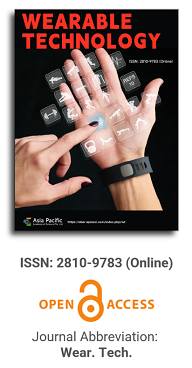

This paper delves deeply into the innovative realm of integrating human emotions with wearable technology. The primary focus is on the conceptualization and development of a kiss transfer device that harnesses the power of wearable technology to bridge the physical gap in human-human interactions. By investigating the intricate nuances of the human-human kissing process, the research seeks to replicate this intimate gesture through a technological medium. The paper not only elaborates on the anatomy, evolution, and hormonal dynamics of kissing but also underscores the transformative potential of wearable technology in capturing and transmitting these intimate moments. This exploration opens up new horizons for long-distance relationships, offering a tangible touchpoint that goes beyond traditional communication methods. Through this pioneering work, the research positions wearable technology as not just a tool for communication but as an extension of our human emotions and expressions.

Design of a portable low-power wearable heart rate and blood oxygen monitoring system
Vol 2, Issue 1, 2021
Download PDF
Abstract
Heart rate, blood oxygen and body temperature are all important physiological information of human body, and designing a small and portable system measurement device will have a large social and clinical economic benefit. An attempt was made to design a portable monitoring device with STM32F103C8T6 as the controller. The heart rate, blood oxygen and body temperature data are collected by MAX30102 and GYMCU90615 modules and the data are sent to an Android smart phone via Bluetooth module for analysis and display, realizing an Android-based heart rate, blood oxygen and body temperature monitoring system. The system has been tested and verified to be stable and reliable.
Keywords
References
- Chen X, Yang J. Development of STM32 based oximetry heart rate detector. Computer Knowledge and Technology 2017; 13(15): 231–233.
- Shang M, Li H, Wan Z, et al. Model construction and empirical study of overseas users’ willingness to continuously use smart health wearable devices: An example of Xiaomi sports bracelet user group in Korea. Mathematical Practice and Understanding 2019; 49(7): 9–19.
- Maeda Y, Sekine M, Tamura T. Relationship between measurement site and motion artifacts in wearable reflected photoplethysmography. Journal of Medical Systems 2011; 35(5): 969–997.
- Xue J, Huang Y, Du X, et al. Bluetooth low-power wearable blood oxygen monitoring design of a device. Chinese Journal of Biomedical Engineering 2015; 34(6): 701–707.
- Zhang Z, Tu Y, Li M, et al. PPG-based heart rate detection for wearable devices detection method. Journal of the College of Logistics Engineering 2017; 33(4): 93–96.
- Xu P, Xu B, Xu W. AFE4400-based pulse oximetry system and degree detection system. Laser and Infrared 2015; (3): 320–324.
- Liang Y, Chen Z, Liu G, et al. A new, short-recorded photoplethysmogram dataset for blood pressure monitoring in China. Scientific Data 2018; (5). doi:10.1038/sdate.2018.20.
- Lee S, Shin H, Hahm C. Effective PPG sensor placement for reflected red and green light, and infrared wristband-Type photoplethysmography. 2016 18th International Conference on Advanced Communication Technology (ICACT) IEEE.
- Zhu S, Zeng B. An Android smartphone-based system for monitoring blood oxygen saturation, heart rate, respiratory rate monitoring system design. Chinese Journal of Medical Devices 2015; 39(3): 183–186.
- Su J, Gui X. Status and development of medical infrared thermometry. Medical and Health Equipment 2016; 37(1): 110–112.
- Chen C. Maxim MAX30102 wearable blood oxygen and heart rate biosensor solution. World Electronic Components 2018; (4): 45–48.
- Zhang W, Wang G. Heart rate detection technology in wearable devices. Shanghai Textile Science and Technology 2017; (1): 12–15.
- Ding X, Zhang Y, Liu J, et al. Continuous cuffless blood pressure estimation using pulse transit time and photoplethysmogram intensity ratio. IEEE Trans Biomed Eng 2016; 63(5): 964–972.
- Liao X. The development constrain and future path of wearable smart devices based on health management. Bulletin of Sport Science and Technology 2019; 27(5): 139–140.
Supporting Agencies
Copyright (c) 2021 Quanyu Wu, Enxiang Jia, Feijie Dai, Wenxi Zhang, Ye Wang, Xiaojie Liu

This work is licensed under a Creative Commons Attribution 4.0 International License.

Prof. Zhen Cao
College of Information Science & Electronic Engineering, Zhejiang University
China, China
Processing Speed
-
-
-
- <5 days from submission to initial review decision;
- 62% acceptance rate
-
-
Asia Pacific Academy of Science Pte. Ltd. (APACSCI) specializes in international journal publishing. APACSCI adopts the open access publishing model and provides an important communication bridge for academic groups whose interest fields include engineering, technology, medicine, computer, mathematics, agriculture and forestry, and environment.





